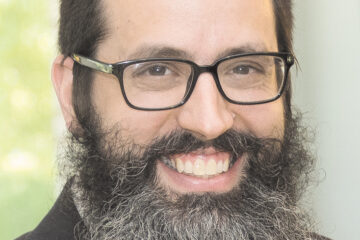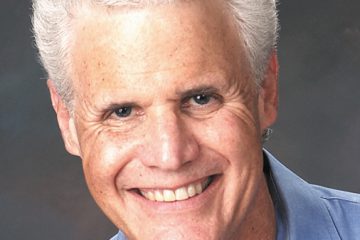Aid for the Transients
Barely remembered today, service delivery for itinerant Jews was a hot topic during the Federation’s first decades
By Marshall Weiss, The Dayton Jewish Observer
Judaism teaches that all Jews are obligated to give tzedakah, to provide righteous giving to those in need. A Jew is required to give to the poor and the homeless.
But what if the person in question is “working the system” or is capable of working and doesn’t? Or if members of the Jewish community are afraid to take in a person who might carry disease, lice or mental illness?
 These social welfare dilemmas were at the center of an almost 50-year struggle among Federation and other Jewish community leaders over how to service Jewish transients who would come through Dayton for a day or two and move on to another town.
These social welfare dilemmas were at the center of an almost 50-year struggle among Federation and other Jewish community leaders over how to service Jewish transients who would come through Dayton for a day or two and move on to another town.
Before the establishment of Dayton’s Federation in 1910, Jews in the East End — home of the more recent Jewish immigrants from Eastern Europe — already had a Hachnosis Orchim organization to provide food, lodging and money to transient Jews. The term hachnosis orchim refers to the Jewish value of hospitality.
By 1912, the Federation approved a motion that “Federation decline to assist any magid (itinerant rabbi or teacher) who receives assistance from anyone else in the city and furthermore that no magid should be helped twice.”
The Federation made it clear that it was willing to help transient Jews but only if they weren’t double dipping.
In 1915, in the absence of the previous Hachnosis Orchim, the Federation agreed to continue to care for transients, but said it would relinquish the duty of caring for transient magids to a newly forming Hachnosis Orchim in the East End.
The Federation urged the new entity to “cooperate as much as possible and not withhold their contributions from Federation.”
Also in 1915, Rabbi David Lefkowitz, chairman of the Federation’s relief committee, solicited junk dealers and other business owners to give temporary employment to transients. There is no indication that this proposition worked out.
Miriam S. Van Baalen, executive secretary of the Federation, expressed her frustration with the transient issue in the Federation’s 1923 annual report.
“The transient pursues the same method wherever he goes — that of soliciting the synagogues and business places, while he is being fed and sheltered by the Federation, and he often makes it his business to arrive at night so that he will be sure of lodging and have the following day for soliciting, rather than working, even if he had the chance.”
The Federation provided services to 128 transients that year.
Dayton’s Jewish community was not alone in trying to solve this problem. In 1928 and ‘29, the national Bureau of Jewish Social Research and more than 30 Jewish organizations around the country studied the issue. At the same time, Dayton’s Community Chest looked at the problem of transients in the general community.
The Great Depression brought with it many more transients passing through the city.
In 1930, Dayton’s Transient Service Bureau was in operation, with lodgings for 81 men.
The following year, Federation provided 919 transients with care; 548 received a night’s lodging, 371 received cash for food, transportation and incidentals.
When Orthodox transient men (mostly elderly) would show up at the Federation, they weren’t sent to the City Transient Bureau; instead, each was given a ticket to stay at a Jewish home. This would ensure kosher meals.
The number of transients the Federation serviced would increase by 105 percent in 1932.
On Dec. 25, 1931, the Federation held a meeting at the Jewish Community Center to come to an agreement to curtail duplication of transient services.
Present at this meeting was Rabbi I. Rackovsky of Wayne Avenue (Beth Abraham) Synagogue. He explained that transients first came to the Federation and then to his synagogue for further assistance.
Rackovsky suggested that a committee from the Wayne Avenue Shul take over all Jewish transient services and that the Federation provide the funding. Very often, the rabbi said, transients arrived in Dayton over the weekend, when the Federation was closed.
He also proposed that if a transient wanted more than two meals and a night’s lodging, transportation or extra money, that under this new plan, the committee would refer the transient back to the Federation.
On Jan. 11, 1932, the executive committee of the Federation approved the plan for Rackovsky and Rabbi Samuel Burick of the Wayne Avenue Shul to oversee the care of Jewish transients in Dayton who were strict in their observance of dietary laws. All others would be referred to the City Transient Service Bureau.
The Federation and Wayne Avenue Shul agreed not to provide Jewish transients with money.
In the words of Federation board member Jacob Margolis at the Dec. 25 meeting, “Giving money to a transient only encourages him to become a bum. The thing to do is eliminate that.”
Federation board member Sam Thal added that “transients discuss these things among themselves and if the word went around that Dayton took care of them in such a way, the whole town would be flooded with bums.”
Members of the Wayne Avenue Shul — mostly Lithuanian Jews — may have been bolstered in their dedication to carry out this mitzvah by their sense of dignity.
The Federation was established in 1910 by German Jewish merchants to care for the needs of the poor Jews who more recently arrived in great numbers from Eastern Europe.
“It has been customary for the early settler to regard the later arrival as inferior,” explained Morris D. Waldman, founder and head of numerous national Jewish programs, in 1916. “The tendency on the part of earlier German Jewish settlers to look askance at the later Russian Jewish immigrants was not to be wondered at.”
In 1927, Harold Silver, of the Bureau of Jewish Social Research, wrote that the Jewish immigrants of Eastern Europe “made no secret of the fact that in addition to desiring a kosher ritual and to help the poor in their own spirit,” they wanted to show the German Jews that they were not schnorers or parasites.
The early 1930s brought hard times to the Wayne Avenue Shul too. According to a history of Beth Abraham by Dr. Leonard Spialter and Dr. Allan Spetter, in June 1931, Rabbis Rackovsky and Burick had not been paid for two months. And the shul had difficulty making its mortgage payments. The majority of congregants couldn’t pay their dues.
As the Depression ground on, the Federation softened its stance on giving money to transients; migrants looking for work had joined their ranks.
 In a 1975 interview with Renate Frydman for the Dayton Jewish Chronicle, Si Burick, son of Rabbi Samuel Burick, recalled sitting at his parents’ dinner table at their home, 40 Bradford St., with guests he had never met before.
In a 1975 interview with Renate Frydman for the Dayton Jewish Chronicle, Si Burick, son of Rabbi Samuel Burick, recalled sitting at his parents’ dinner table at their home, 40 Bradford St., with guests he had never met before.
“Traveling rabbis, bearded and dressed in the traditional apparrel sipped tea and studied Talmud with Rabbi Burick,” Frydman wrote. “Their home was one stop on the ’rounds.'” Si Burick recalled that at the JCC at 59 Green St., the itinerant travelers took part in daily minyans and were given enough money for a ticket to the next town. Rabbi Burick often gave money from his own pocket to see the travelers on their way.
Si Burick’s brother, Lee, also recalled in the article that the flow of bearded men to 40 Bradford St. continued long after the Buricks had moved away. As a young man, he delivered coal and was called to make a delivery to a new resident at 40 Bradford St. When he told the woman of the house that he used to live there, she asked him, “Do you know who all these bearded men are who ring my doorbell?”
The Federation reported that 1,083 Jewish transients sought aid in 1938, ages 10 to 75, including two families. Of these, the Federation provided 981 men with a small cash allowance for food; 88 Jewish men accepted a night’s lodging at the City Transient Bureau.
In April 1939, the Federation convened another meeting to try to centralize and streamline Jewish transient services.
Once again, the issues were duplication of services and cash expended.
“The transient,” Wayne Avenue Shul’s Philip Kravitz pointed out, “receives cash from both synagogues, from the Hebrew Ladies Benevolent Society and then solicits the businessmen in the city.”
Kravitz suggested that arrangements be made with a Jewish family to house and feed the transients, that every man coming to the Federation or the synagogues would receive a ticket for lodging and meals but that no cash be given to him.
Sam Thal said it was unfair to subject any family to the care of those men.
“Many come in diseased, dirty and their clothes unkept, that no home in Dayton, even if they wanted to house transients, has the proper facilities to take care of them,” Thal said.
This time, the Federation decided that it would work with all Jewish transients coming to Dayton. They would lodge at the City Transient Service Bureau, the Federation would refer Orthodox clients to receive kosher food, and transients weren’t to receive cash from synagogues or other organizations.
By February 1942, two months after the United States entered World War II, the Federation reported that both its transient service and the City Transient Bureau’s had shown a decrease in the number of people served and monies expended.
But at the Federation’s 1942 annual meeting, Executive Secretary Jane Fisher indicated that “a new type of civilian transient is developing — one who seeks employment in defense industries and who is not equipped to meet requirements.”
Mention of transients as an issue of concern is nowhere to be seen in Federation’s records, brochures and newsletters of the 1950s.
By the mid 1960s, the Federation’s Jewish Family Service handled a few transient cases a month and even that was on the decline: from 59 in 1966 to 43 in 1970.
According to Sheldon Switkin, who served as director of Jewish Family Service from 1982 to 2002, his department handled approximately a dozen transient cases a year during his tenure, keeping confidential records.
“A few were ‘professional transients,'” he recalled, “but many others were authentic hard luck stories that were verified.”
Today, the Jewish Fedederation Social Service Department still handles transient cases, though only about four or five a year. These transients, Jewish men, travel by bus from city to city, requesting assistance from Jewish federations and synagogue rabbis. Dayton’s Jewish Federation provides these transients with bus fare, and gift cards to “big box” stores for purchases of essentials. On their way through town, some stay at hotels overnight, others at homeless shelters.






